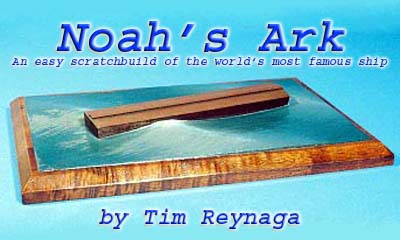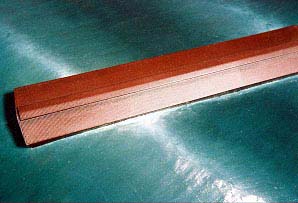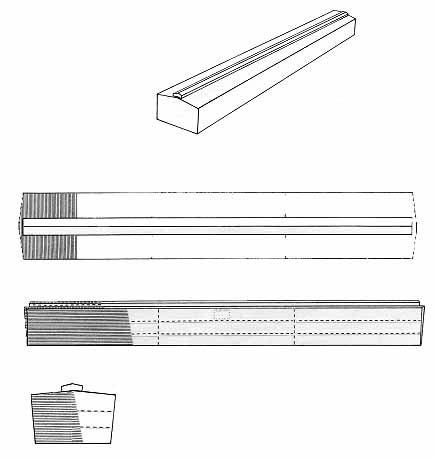 |
| We’re all familiar with the story of Noah, the Great Flood,
and Noah’s Ark. The Ark itself is a frequently seen image, but most
depictions of it are pure fantasy. What might such a vessel have
actually looked like? I thought it would be fun to take the story
seriously and do a “realistic” model of the Ark, so using physical descriptions
from the Bible and other ancient documents, I set to work. |
|
|
Divine Plans. The ancient sources all agree
that the Ark was designed by God (or the Gods). The specifications
of the vessel in the ancient Hebrew book of Genesis were the most
detailed:
| “...And God said unto Noah, Make thee an Ark of Gopher wood:
rooms shalt thou make in the Ark, and shalt pitch it within and without
with pitch. And this is the fashion which thou shalt make it of:
The length of the Ark shall be three hundred cubits, the breadth of it
fifty cubits and the height of it thirty cubits. A window thou shalt
make in the Ark, and in a cubit shalt thou finish it above; and the door
of the Ark shalt thou set in the side thereof; with lower, second, and
third stories shalt thou make it.” (Genesis 6:14-16). |
Given 18” cubits, the biblical Ark would have been approximately 450
feet long, 75 feet wide, and 45 feet high. The hull would have been
sealed with pitch, had some sort of window topside, a door on the side,
and three decks.
I reasoned that the unpowered vessel would probably have resembled
a barge more than a seagoing ship. The ancient Hebrew word for the
Ark, tebah, does not mean “boat” or “ship”. It is etymologically
related to the Egyptian word db’at, meaning “box” or “chest”, suggesting
a squarish, barge-like craft. The 4,700 year old Akkadian Epic of
Gilgamesh (Tablet IX, line 59) and the Babylonian Atra Hasis (Tablet III,
lines 25-6) both refer to the Ark’s “square decks”. Finally, ancient
Mesopotamian traditions held that Noah was from the city of Shurrupak on
the Euphrates River, so a river barge type design would be natural.
I decided on a very plain layout, with flat surfaces and gentle slopes.
| “Make thee an Ark...” The first step in construction was
to cut the pieces out of plastic sheet to match my 1/700 scale plans.
I cut the hull parts from Evergreen .040 inch thick v-groove siding with
.030 inch spaced grooves (product #4030) and the roof parts from .030 inch
thick passenger car siding with .025 inch grooves (product #3025).
I like the easy to work Evergreen plastic, and the mass of delicate grooves
on the sheets would nicely simulate the wooden construction of the vessel.
Since I didn’t plan to show the interior of the Ark the model was very
simple, consisting of just twelve parts. |
 |
| I began assembly by bending the roof downward along its centerline
over a straight edge to fit over the peaks of the bow and stern parts.
These I cemented into place after having similarly bent them to fit the
curves at the ends of the roof. Two interior bulkheads made from
the .040 inch hull material were included for added rigidity. To my surprise,
these showed through the roof after the cement had dried. The cement
applied to the thick bulkhead edges had slightly distorted the thinner
material of the roof. Still faintly visible on the exterior of the
completed model after painting, they subtly suggest an inner structure.
A happy accident! |
 |

|
| Windows. According to Genesis 6:16, “A sohar thou shalt
make to the Ark and in a cubit thou shalt finish it above...” The
obscure ancient Hebrew word sohar is traditionally rendered as “window”.
A window usually means an aperature in a structure, but the sohar is “above”
the main structure by one cubit. For this to be so, the opening would
have to be part of a separate section elevated above the main roof.
The sohar must have been this structure with ventilation openings rather
than a window as such. This would also explain the Babylonian account’s
“let it be roofed over above and below” (Atra Hasis Tablet III, line 31),
“so that the sun shall not see inside it”, which apparently distinguishes
the roof of the sohar above from the vessel’s main roof below it. |
 |
| The roof of the sohar was cut and formed just like the
roof of the hull. The sides were made from Evergreen HO scale ladder
kit parts (product #201), which came precut with small rectangular notches.
When attached beneath the sohar roof these notches became rectangular vents
running the length of the ship, providing a nice see-through effect when
viewed from directly abeam. |
| Painting. According to the Bible, the Ark was sealed "…within
and without with pitch" (Gen 6:14). The fragmentary Epic of Gilgamesh
says “the little ones [carr]ied bitumen...six sars of asphalt I also poured
inside...” (Tablets XI, lines 54 and 66), and the Atra Hasis says, “...let
the pitch be tough and so give (the vessel) strength” (Tablet III, line
33). |
 |
| Based on these accounts it would have been reasonable to
paint the Ark gloss black overall, but that would not tend to impart the
impression of a wooden ship. I chose instead to paint it a "Gopher
wood" brown (Tamiya Color acrylic flat brown XF-10) with the seams "caulked"
with gloss black enamel applied as a thin wash. The Ark then received
a gentle drybrushing with the lightened base color to provide some highlights.
Finally, a misting of gloss varnish gave the ship a slightly wet look. |
| The Great Flood- in 1/700 scale. To add interest to the
very plain model I placed it in a heavy, rolling sea. The Ark was
heeled over just a bit, with the lower 1/3 of the hull cut away to give
it a more natural “sit” in the swells. The water was sculpted from
drywall spackle and painted with Testors Non-Specular Sea Blue (FS 35042)
and white. |
 |
There it was, a quick and easy Ark. My interpretation,
though based on the limited information available, is admittedly speculative.
Still, until somebody finds the wreck on Mount Ararat, who is to say I
didn’t get it right?
|
| REFERENCES
Holy Bible (Authorized King James Version of 1611), American
Bible Society, New York, New York, 1999
Atra Hasis, The Babylonian Story of the Flood Dr. W.G Lambert
(Editor), et al., Oxford University Press, Oxford, UK, 1969
Ancient Near Eastern Texts Dr. J.B. Prichard (Editor), Princeton
University Press, Princeton, New Jersey, 1955
The Epic of Gilgamesh N.K. Sandars (Translator), Penguin Classics,
London, UK, 1964
SOURCES
Styrene plastic stock Evergreen Scale Models, Inc. 18620-F 141st
Ave. NE, Woodinville, Washington 98072 www.evergreenscalemodels.com |






